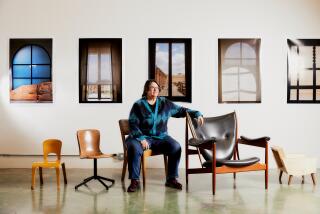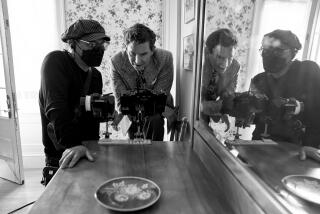The Bottom Line on Sitting and Its Consequences
- Share via
For years, my father-in-law has brought home stray chairs that have sat around his study like a gaggle of mutts at an obedience convention. One we nicknamed Grandma’s chair, for obvious reasons, a second the Roller, since it slides from upright to prone (often over infant fingers) on an arched runner, and a third we called the Gynecologist’s Chair and sat upon at our peril.
Thanks to Galen Cranz, a professor of architecture at UC Berkeley, I now know that Grandma’s pedigree name is the Wassily (named by the designer Breuer after his friend, the artist Wassily Kandinsky), the Roller is more properly Le Corbusier, and the ob-gyn is well-known on the circuit as the Gravity Chair. And thanks to my mother-in-law, all three have been replaced by wide-armed, broad-bummed comfy chairs that bark less loudly and would never bite a child.
The Great Chair War between my in-laws foreshadowed much of the subject of Cranz’s “The Chair: Rethinking Culture, Body and Design.” Visual beauty and physical comfort have fought each other throughout the centuries for the right to cradle the occidental posterior. And Cranz, whose resume includes years of t’ai chi ch’uan, jun shin, acupuncture, Iyengar-style yoga and professional certification as a teacher of the Alexander Technique, seems like the perfect political analyst.
She chronicles the first appearances of the chair with pictures of clay models from the Neolithic era of full-figured females seated on four-legged chairs with backs. She also details the evolution of the chair in the West as a symbol of power, a way to rise above “Muslims, animals and women,” as the Spaniards did in the 13th century. She follows the development of the field of ergonomics and the efforts of chair designers to rid the chair of its inevitable companion, back pain.
*
Yet Cranz is no sedentary historian. “The Chair” is a call to action.
“Bodies were here first,” she writes. “I have come to believe that chairs are hazardous to our health.”
A wealth of physical disorders, from back pain to gastrointestinal problems to varicose veins, can be linked to the dangerous act of sitting. “After many years of training in various body-mind disciplines, I finally recognized that a cultural assumption lay hidden . . . that sitting at the edge of a seat upright, without support, is too tiring to sustain.” She points to photographs of men from Burkina Faso who have tremendous postures that have never been subjected to the rigors of missionaries, and to the experience of Asian peoples who have weathered thousands of chairless years.
Ultimately, Cranz is a realist and acknowledges that chairs are here to stay. By the end, she petitions for more flexibility in the sitting room--carpets and raised platforms for lying as well as chairs that support “the sit bones”--as opposed to what my father-in-law calls the “sitzfleisch.” “The Chair” could be reasonably subtitled: “How I Stopped Worrying and Learned to Love the Chair.” Which my mother-in-law eventually did. She bought a backless Norwegian Balans chair for her desk.
More to Read
The biggest entertainment stories
Get our big stories about Hollywood, film, television, music, arts, culture and more right in your inbox as soon as they publish.
You may occasionally receive promotional content from the Los Angeles Times.










